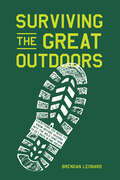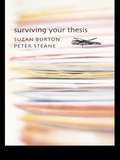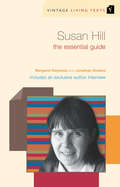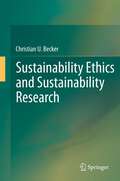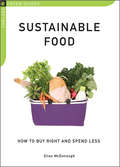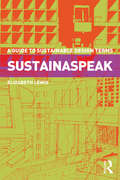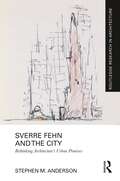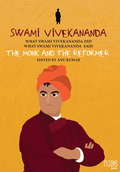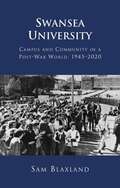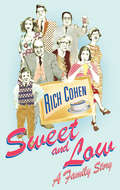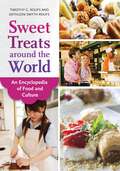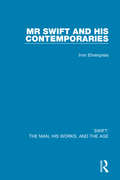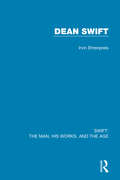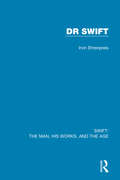- Table View
- List View
Surviving the Great Outdoors: Everything You Need to Know Before Heading into the Wild (and How to Get Back in One Piece)
by Brendan LeonardFrom how to fight off a bear and how to identify poison ivy to how to rappel down a mountain and select the right sleeping bag for cold-weather camping, this intro-level guide teaches the skills that anyone can use to thrive in the great outdoors.
Surviving Your Thesis
by Suzan Burton Peter SteaneFrom choosing a supervisor and topic to staying motivated, completing a research thesis is not an easy matter. Each stage represents a different challenge and many students struggle through without identifying the skills needed to make the most of their time. This wonderful resource for all doctoral and masters level students, explores the challenges and complexities of successfully engaging in the research process and thesis writing. Chapters include: choosing and working with a supervisor developing a research proposal motivating yourself choosing the right research method responding to criticism advice from the examiners preparing work for publication. This clear and practical guide, ideal for all doctoral and masters level students, takes readers from the very early stages of the process through to the final phase of examination and publication, using vignette examples to highlight key issues.
Surviving Your Thesis
by Suzan Burton Peter SteaneFrom choosing a supervisor and topic to staying motivated, completing a research thesis is not an easy matter. Each stage represents a different challenge and many students struggle through without identifying the skills needed to make the most of their time. This wonderful resource for all doctoral and masters level students, explores the challenges and complexities of successfully engaging in the research process and thesis writing. Chapters include: choosing and working with a supervisor developing a research proposal motivating yourself choosing the right research method responding to criticism advice from the examiners preparing work for publication. This clear and practical guide, ideal for all doctoral and masters level students, takes readers from the very early stages of the process through to the final phase of examination and publication, using vignette examples to highlight key issues.
Susan Hill: The Essential Guide (Vintage Living Texts #13)
by Jonathan Noakes Margaret ReynoldsThe Woman in Black, Strange Meeting, I'm the King of the Castle, A Little Bit of Singing and DancingIn Vintage Living Texts, teachers and students will find the essential guide to the works of Susan Hill. Vintage Living Texts is unique in that it offers an in-depth interview with Susan Hill, relating specifically to the texts under discussion. This guide deals with Hill's themes, genre and narrative technique, and a close reading of the texts will provide a rich source of ideas for intelligent and inventive ways of approaching the novels. Also included in this guide are detailed reading plans for all three novels, questions for essays and discussion, contextual material, suggested texts for complementary and comparative reading, extracts from reviews, a critical overview, a biography, bibliography and a glossary of literary terms.
Susan Stebbing and the Language of Common Sense (History of Analytic Philosophy)
by S. ChapmanThis first book-length study of the work and life of L. Susan Stebbing relates the development of her thought to the philosophical, social and political background of her life. It also assesses Stebbing's contribution in the light of developments both in analytic philosophy and in linguistics in the decade since her death.
Sustainability Ethics and Sustainability Research
by Christian BeckerThe book identifies the specific ethical aspects of sustainability and develops ethical tools to analyze them. It also provides a methodological framework to integrate ethical and scientific analyses of sustainability issues, and explores the notion of a new type of self-reflective inter- and transdisciplinary sustainability research. With this, the book aims to strengthen the overall ability of academics to contribute to the analysis and solution of sustainability issues in an inclusive and integrated way.
Sustainable Development: Constraints and Opportunities
by Mostafa Kamal TolbaSustainable Development: Constraints and Opportunities contains a selection of the author's speeches made between 1982 and 1986. During this 5-year period knowledge of environment-development relationships has grown considerably, and this evolving perception can be discerned in his statements spanning those years. Taken together, the common thread binding all the speeches is the fact that long-term development can only be achieved through sound environmental management, that is, sustainable development, which is the title of this book. The speeches included in this volume were delivered in the author's capacity as the Executive Director of the United Nations Environment Programme (UNEP). They thus cover primarily broad areas of interest of UNEP's programs and policies. Key topics discussed include environmental protection; disarmament and the environment; environmental information for engineers; the impact of human settlements on the environment; environmental management in the Gulf; the causes, effects, and prevention of desertification; and the environmental impact assessment process.
The Sustainable Development Theory: When Certainties Become Doubts (Palgrave Studies in Sustainability, Environment and Macroeconomics)
by Ion Pohoaţă Delia Elena Diaconaşu Vladimir Mihai CrupenschiThis book explores the present conflictual relationship between the economy, the environment, and society. The current mainstream economic model is analysed from the perspective of the founding economists to review its suitability to tackle issues of sustainable development. The problems of redistribution and social justice are debated at length; alongside those concerning the giant state, degrowth, and a vision of sustainability that is founded on the idea of a self-regulating free market economy. Business cycle sustainability, anti-crisis therapy, technological unemployment, the natural rate of interest, and the Bruntland matrix are also examined.This book aims to present a holistic approach to sustainable development where social, ecological, and economic components are balanced. It will be relevant to students and researchers interested in this topic.
Sustainable Food: How to Buy Right and Spend Less (Chelsea Green Guides)
by Elise McDonoughWondering whether it’s worth it to splurge on the locally raised beef? What about those organic carrots? New in the Chelsea Green Guides series, Sustainable Food: How to Buy Right and Spend Less helps the average shopper navigate the choices, whether strolling the aisles of a modern supermarket or foraging at a local farmers market. This down-to-earth, casual guide—small enough to be slipped into your pocket—answers these and other questions for the shopper: What are the differences among organic, local, fair-trade, free-range, naturally raised, and biodynamic foods? How affordable is it to subscribe to a CSA farm—and what are the advantages? Is it better to choose wild Alaskan salmon at $18.99, or the Chilean farmed fish at $11.99? What cooking oils can be sustainably sourced? How can a food co-op increase access to, and affordability of, healthier, Earth-friendly foods? Where can you find sustainably produced sugar, and are there any local replacements for sweeteners from faraway lands? What do the distinctions between shade-grown and trellised coffee mean? Is shark okay to eat? How about mackerel? Why is the war on plastic bags so important? Sustainable eating just got easier.
Sustainaspeak: A Guide to Sustainable Design Terms
by Elizabeth LewisArchitecture 2030; BUG; Biophilic Design; BIPV; Circular Economy; LEED; Passive Design; Solar Chimney; Systems Thinking; WELL; Xeriscaping. What does it all mean? The complex and evolving language used in the sustainable design community can be very challenging, particularly to those new to environmentally friendly and resource-efficient design strategies that are needed today. Definitions of over two hundred terms with further sources. Clearly cross-referenced with Sustainaspeak, Theoryspeak, and Archispeak terms. Illustrated throughout with sustainable award-winning buildings by e.g. Behnisch, Brooks + Scarpa, EHDD, KieranTimberlake, Lake|Flato, Leddy Mahtum Stacy, SmithGroup, Perkins+Will, ZGF, VMDO, and McDonough + Partners. Sustainaspeak: A Guide to Sustainable Design Terms provides a current guide to the sustainable design strategies, terms, and practices needed for the next generation of designers, architects, students, and community leaders to design a carbon-neutral world for future generations.
Sustainaspeak: A Guide to Sustainable Design Terms
by Elizabeth LewisArchitecture 2030; BUG; Biophilic Design; BIPV; Circular Economy; LEED; Passive Design; Solar Chimney; Systems Thinking; WELL; Xeriscaping. What does it all mean? The complex and evolving language used in the sustainable design community can be very challenging, particularly to those new to environmentally friendly and resource-efficient design strategies that are needed today. Definitions of over two hundred terms with further sources. Clearly cross-referenced with Sustainaspeak, Theoryspeak, and Archispeak terms. Illustrated throughout with sustainable award-winning buildings by e.g. Behnisch, Brooks + Scarpa, EHDD, KieranTimberlake, Lake|Flato, Leddy Mahtum Stacy, SmithGroup, Perkins+Will, ZGF, VMDO, and McDonough + Partners. Sustainaspeak: A Guide to Sustainable Design Terms provides a current guide to the sustainable design strategies, terms, and practices needed for the next generation of designers, architects, students, and community leaders to design a carbon-neutral world for future generations.
Sustaining Surveillance: The Importance of Information for Public Health (Public Health Ethics Analysis #6)
by John G. Francis Leslie P. FrancisThis book presents a comprehensive theory of the ethics and political philosophy of public health surveillance based on reciprocal obligations among surveillers, those under surveillance, and others potentially affected by surveillance practices. Public health surveillance aims to identify emerging health trends, population health trends, treatment efficacy, and methods of health promotion--all apparently laudatory goals. Nonetheless, as with anti-terrorism surveillance, public health surveillance raises complex questions about privacy, political liberty, and justice both of and in data use. Individuals and groups can be chilled in their personal lives, stigmatized or threatened, and used for the benefit of others when health information is wrongfully collected or used. Transparency and openness about data use, public involvement in decisions, and just distribution of the benefits of surveillance are core elements in the justification of surveillance practices. Understanding health surveillance practices, the concerns it raises, and how to respond to them is critical not only to ethical and trustworthy but also to publicly acceptable and ultimately sustainable surveillance practices. The book is of interest to scholars and practitioners of the ethics and politics of public health, bioethics, privacy and data technology, and health policy. These issues are ever more pressing in pandemic times, where misinformation can travel quickly and suspicions about disease spread, treatment efficacy, and vaccine safety can have devastating public health effects.
Sverre Fehn and the City: Rethinking Architecture’s Urban Premises (Routledge Research in Architecture)
by Stephen M. AndersonThe urban attentions of Pritzker Laureate Sverre Fehn (1924–2009) are extensive, but as yet virtually unexplored. This book examines ten select projects to illuminate Fehn’s approach to the city, the embodiment of that thinking in his designs, and the broader lessons those efforts offer for better understanding the relationship between architecture and urban life, with unignorable implications for emergent urban architecture and its address of sociological and ecological crises. Wary of large-scale planning proposals or the erasure of existing urban patterns, Fehn offered an uncommon and profoundly vibrant approach to urbanism at the scale of the single architectural project. His writings, constructed buildings, competition entries, and lectures suggest opportunities for reinvigorating architecture’s engagement with the city, and provoke a rethinking of concepts foundational to its theorization. What is the nature of urbanity? What is the relationship of urbanity to the natural world? What is the role of architecture in the provision and sustenance of urban life? While exploring this territory will expand our knowledge of an architect central to key developments of late modernism, the range of the book and the arguments developed therein delineate far broader aims: a fuller understanding of architecture’s urban promise.
Sverre Fehn and the City: Rethinking Architecture’s Urban Premises (Routledge Research in Architecture)
by Stephen M. AndersonThe urban attentions of Pritzker Laureate Sverre Fehn (1924–2009) are extensive, but as yet virtually unexplored. This book examines ten select projects to illuminate Fehn’s approach to the city, the embodiment of that thinking in his designs, and the broader lessons those efforts offer for better understanding the relationship between architecture and urban life, with unignorable implications for emergent urban architecture and its address of sociological and ecological crises. Wary of large-scale planning proposals or the erasure of existing urban patterns, Fehn offered an uncommon and profoundly vibrant approach to urbanism at the scale of the single architectural project. His writings, constructed buildings, competition entries, and lectures suggest opportunities for reinvigorating architecture’s engagement with the city, and provoke a rethinking of concepts foundational to its theorization. What is the nature of urbanity? What is the relationship of urbanity to the natural world? What is the role of architecture in the provision and sustenance of urban life? While exploring this territory will expand our knowledge of an architect central to key developments of late modernism, the range of the book and the arguments developed therein delineate far broader aims: a fuller understanding of architecture’s urban promise.
Swami Vivekananda: The Monk and The Reformer: What Swami Vivekananda Did, What Swami Vivekananda Said (What They Did, What They Said Series)
by Anu Kumar‘Take up one idea. . . Make that one idea your life. . . This is the way to success’ Single-minded and multifaceted, the master of many subjects and devoted disciple of Shri Ramakrishna, Swami Vivekananda was a global citizen far ahead of his times. At once a yogi and worldly-wise, this early ambassador of India introduced the western world to Indian civilization, while he encouraged Indians to discard divisive rituals and social hierarchies to build a united, equal, modern nation. A dedicated but free-thinking student, a reformer, teacher and writer, he was an eloquent orator whose speeches – especially at the World Parliament of Religions in Chicago – put Indian spirituality and philosophy on the map, and ignited hearts and minds everywhere. His way was both of meditation and action, leading from the front while humbly serving the poor. He put his faith in young people and exhorted them to work towards regenerating India. It is not surprising then that National Youth Day in India is celebrated on the birthday of Swami Vivekananda, a leading light then, and an inspiration now and forever. This book brings together Swami Vivekananda’s stellar work and words, and highlights the main tenets of his life. From his regretfully short but exceptional life, you too can learn to be a little bit like Swami Vivekananda.
Swan: Portrait of a Majestic Bird, from Mythical Meanings to the Modern Day
by Dan KeelBook of the Month, Countryside magazine‘[this] fascinating new book… provides a detailed insight into the snow-white species’ Waterways WorldA wildlife writer and photographer’s celebration of the mute swan, Britain’s most iconic breed, exploring the bird’s significance across myth and history alongside vivid observations on its habits and habitats.The swan is both a lover and a fighter. A graceful angel and a clumsy oaf. Immortalized by artists over the ages yet misunderstood and threatened in the present day. The mute swan – with its orange beak and aura of stately silence – is the breed we know best in Britain.Dan Keel has been captivated by these birds since boyhood, studying their contrasting qualities over more than three decades. He’s spent countless hours documenting their power, beauty and vulnerability as a writer of nature journalism, as a wildlife photographer looking for the perfect shot, and as a pilot sharing the skies.In this labour of love, Dan speaks up for the mute, answering the essential questions about its nature and its future. Along the way, weaving his first-hand observations into the narrative, he shows us how swans have been portrayed in myth, art and culture for millennia, and how they have been venerated and imitated as well as harmed by humans.Does anybody still eat swan? Can a swan really break your arm? Does the Queen own them all? With an eye for the humour as well as the tragedy of the swan’s story, Dan lays out the facts, guides us to our lakes and riverbanks, and urges us to see these familiar creatures in a fresh light.
Swansea University: Campus And Community In A Post-war World, 1945-2020 (Emersion: Emergent Village Resources For Communities Of Faith Ser.)
by Sam BlaxlandSwansea University: Campus and Community in a Post-War World, 1945-2020 marks Swansea University's centenary. It is a study of post- Second World War academic and social change in Britain and its universities, as well as an exploration of shifts in youth culture and the way in which higher education institutions have interacted with people and organisations in their regions. It covers a range of important themes and topics, including architectural developments, international scholars, the changing behaviours of students, protest and politics, and the multi-layered relationships that are formed between academics, young people and the wider communities of which they are a part. Unlike most institutional histories, it takes a 'bottom-up' approach and focuses on the thoughts, feelings and behaviours of people like students and non-academic staff who are normally sidelined in such accounts. As it does so, it utilises a large collection of oral history testimonies collected specifically for this book; and, throughout, it explores how formative, paradoxical and unexpected university life can be.
Sweet and Low: A Family Story
by Rich CohenRich Cohen's maternal grandfather was called Ben Eisenstadt. Ben was one of those Jews that, with an anger bred of exclusion, went on to reshape the world. He did so by inventing Sweet 'n Low, a granulated sweetener which, in its tiny pink packet, is still found on every table in every diner in America. This simple invention spawned one of the great American fortunes. This is the story of that fortune, how it was made and how it remade and tore apart everyone who touched it.In Sweet and Low, Rich Cohen - the youngest son of Ben's favourite daughter - takes a journey into his own and his family's past. It is a story of family feuds (his mother was eventually disinherited by her mother), eccentricity verging on madness, gangsters, lawyers, corruption, accountants, ex-wives - a quest for a secret history, a black comedy of the American dream.
Sweet Treats around the World: An Encyclopedia of Food and Culture
by Timothy G. Roufs Kathleen Smyth RoufsFrom apple pie to baklava, cannoli to gulab jamun, sweet treats have universal appeal in countries around the world. This encyclopedia provides a comprehensive look at global dessert culture.Few things represent a culture as well as food. Because sweets are universal foods, they are the perfect basis for a comparative study of the intersection of history, geography, social class, religion, politics, and other key aspects of life. With that in mind, this encyclopedia surveys nearly 100 countries, examining their characteristic sweet treats from an anthropological perspective. It offers historical context on what sweets are popular where and why and emphasizes the cross-cultural insights those sweets present. The reference opens with an overview of general trends in desserts and sweet treats. Entries organized by country and region describe cultural attributes of local desserts, how and when sweets are enjoyed, and any ingredients that are iconic. Several popular desserts are discussed within each entry including information on their history, their importance, and regional/cultural variations on preparation. An appendix of recipes provides instructions on how to make many of the dishes, whether for school projects or general entertaining.
Sweet Treats around the World: An Encyclopedia of Food and Culture
by Timothy G. Roufs Kathleen Smyth RoufsFrom apple pie to baklava, cannoli to gulab jamun, sweet treats have universal appeal in countries around the world. This encyclopedia provides a comprehensive look at global dessert culture.Few things represent a culture as well as food. Because sweets are universal foods, they are the perfect basis for a comparative study of the intersection of history, geography, social class, religion, politics, and other key aspects of life. With that in mind, this encyclopedia surveys nearly 100 countries, examining their characteristic sweet treats from an anthropological perspective. It offers historical context on what sweets are popular where and why and emphasizes the cross-cultural insights those sweets present. The reference opens with an overview of general trends in desserts and sweet treats. Entries organized by country and region describe cultural attributes of local desserts, how and when sweets are enjoyed, and any ingredients that are iconic. Several popular desserts are discussed within each entry including information on their history, their importance, and regional/cultural variations on preparation. An appendix of recipes provides instructions on how to make many of the dishes, whether for school projects or general entertaining.
Swift: Volume One: Mr Swift and his Contemporaries (Swift: The Man, his Works, and the Age)
by Irvin EhrenpreisFirst published in 1962, Mr Swift and his Contemporaries, is the first of three volumes providing a detailed exploration of the events of Swift’s life. This volume is a thorough insight into the historical and social setting of Swift’s life, the evolution of his character, and the composition and interpretation of his works. It includes a wealth of material concerning Swift’s family and career, his emotional and sexual life, his relationship with Sir William Temple, and the design and meaning of both A Tale of a Tub and The Battle of the Books. Mr Swift and his Contemporaries is ideal for anyone with an interest in Swift’s life, work, and the period in which he lived.
Swift: Volume Three: Dean Swift (Swift: The Man, his Works, and the Age)
by Irvin EhrenpreisFirst published in 1983, Dean Swift is the concluding book in a series of three volumes providing a detailed exploration of the events of Swift’s life. The third volume follows Swift’s life and career from 1714 to 1745 and sets it against the public events of the age, paying close attention to political and economic change, ecclesiastical problems, social issues, and literary history. It traces Swift’s rise to becoming first citizen of Ireland and looks in detail at the composition, publication, and reception of Gulliver’s Travels, as well as many of Swift’s other works, both poetry and prose. It also explores Swift’s later years, his love affairs with Esther Johnson and Esther Vanhomrigh, his complicated friendships with Pope, Lord Bolingbroke, and Archbishop King, and his declining health. Dean Swift is a hugely detailed insight into Swift’s life from 1714 until his death and will be of interest to anyone wanting to find out more about his life and works.
Swift: Volume Two: Dr Swift (Swift: The Man, his Works, and the Age)
by Irvin EhrenpreisFirst published in 1967, Dr Swift is the second of three volumes providing a detailed exploration of the events of Swift’s life. This volume begins by assessing Swift’s character, hopes and ambitions in 1699. It then traces his life and career up to 1714 in minute detail, giving close consideration to Swift’s expectations and the extent to which he felt they were fulfilled. In doing so, it covers Swift’s movement between Ireland and England, his reputation as a poet, his historical writing, his church preferments, involvement in politics, and much more, including his relationships with a number of prominent social figures of the time. Dr Swift is ideal for those with an interest in Swift’s life, and in particular his life and career between 1699 and 1714.
Swift: Volume Three: Dean Swift (Swift: The Man, his Works, and the Age)
by Irvin EhrenpreisFirst published in 1983, Dean Swift is the concluding book in a series of three volumes providing a detailed exploration of the events of Swift’s life. The third volume follows Swift’s life and career from 1714 to 1745 and sets it against the public events of the age, paying close attention to political and economic change, ecclesiastical problems, social issues, and literary history. It traces Swift’s rise to becoming first citizen of Ireland and looks in detail at the composition, publication, and reception of Gulliver’s Travels, as well as many of Swift’s other works, both poetry and prose. It also explores Swift’s later years, his love affairs with Esther Johnson and Esther Vanhomrigh, his complicated friendships with Pope, Lord Bolingbroke, and Archbishop King, and his declining health. Dean Swift is a hugely detailed insight into Swift’s life from 1714 until his death and will be of interest to anyone wanting to find out more about his life and works.
Swift: Volume One: Mr Swift and his Contemporaries (Swift: The Man, his Works, and the Age)
by Irvin EhrenpreisFirst published in 1962, Mr Swift and his Contemporaries, is the first of three volumes providing a detailed exploration of the events of Swift’s life. This volume is a thorough insight into the historical and social setting of Swift’s life, the evolution of his character, and the composition and interpretation of his works. It includes a wealth of material concerning Swift’s family and career, his emotional and sexual life, his relationship with Sir William Temple, and the design and meaning of both A Tale of a Tub and The Battle of the Books. Mr Swift and his Contemporaries is ideal for anyone with an interest in Swift’s life, work, and the period in which he lived.
